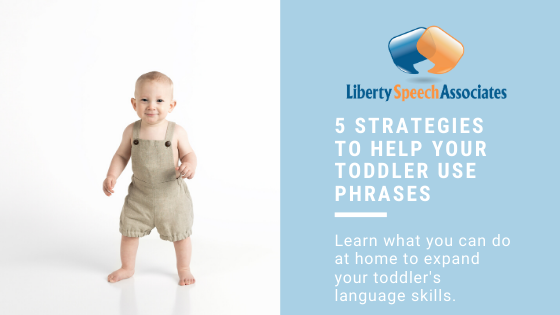Toddlers, typically around 18-24 months, start to independently combine words into simple, two-word phrases. For example, a toddler might say something like “mommy go” or “me eat.” If your toddler is saying single words, but has not yet begun putting words together, try these 5 simple strategies that you can easily implement at home.
1. Ask Open-Ended Questions
Open-ended questions naturally require more than a single word response. By asking these types of questions, you are encouraging your child to use more language rather than just a simple “yes” or “no.”
2. Use Expansions
Expansions take what your child has already said and expands it into a phrase or sentence. For example, if your child says “ball,” you could expand by saying “big ball” or “that’s a big ball.” Try to only add a few additional words so that it is easier for your child to understand and try to repeat. Also, be sure that you use grammatically correct phrases and sentences during your expansions. For instance, if your child is driving a truck and says “truck,” you would want to model “the truck is driving” vs. “truck drive.”
3. Describe Activities & Actions
As you and your child are performing different activities, narrate what is happening. For example, if you are sweeping the floor, you can say, “Mommy’s sweeping the floor.” Although you might feel silly describing your activities (my husband used to think I was nuts when I did this with my son!), you are providing a demonstration to your toddler on how to combine words in an appropriate way.
4. Model Phrases
A model is saying something you want your child to say, in this case a phrase. Make sure to model phrases which include words that your child already knows as this will make it easier for him to repeat you. In other words, if your child knows the words “more” and “cheese,” but is not yet saying them together, you could model the phrase “more cheese” during snack time.
5. Use Pictures & Books
Reading books and looking at pictures allow for excellent language growth. Try showing your child a picture of a recent activity, like a trip to the zoo, and encourage him to talk about what happened. While reading books, ask your child questions about the stories and/or the pictures.
With any attempt your child makes at communicating, positively reinforce him so he feels motivated to do more. Remember to meet your child where he is and not expect drastic changes overnight. Each small step leads to overall giant gains in communication development.
Not sure what your child should be doing at his age? Read my Speech and Language Milestones post. If your child seems behind for his/her age, it is recommended that you seek a comprehensive speech and language evaluation by a certified and licensed speech-language pathologist.

